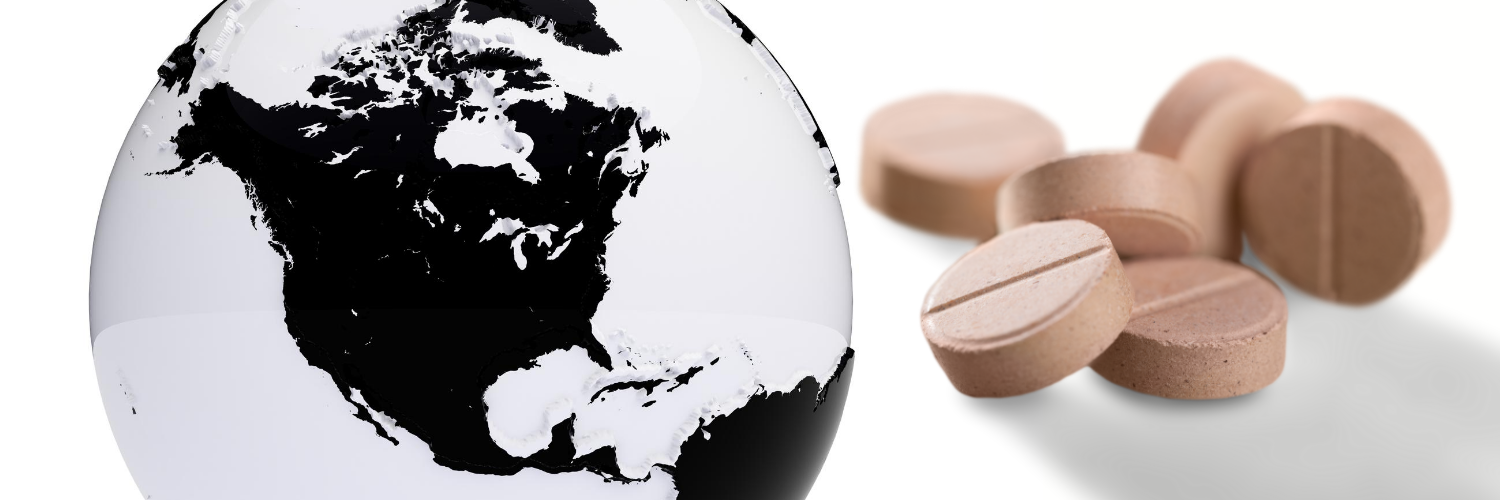Negotiated Medicare drug prices go into effect in 2026. What do patients do in the meantime?

Medicare is finally able to negotiate pricing on medication -- and yet your drug bill is still outrageous. What gives?
1. Those negotiations start with only a batch of ten eligible drugs.
2. The negotiated price doesn't go into effect until 2026.
Certainly tackling Medicare spending is a worthy pursuit, but the drug price crisis in the United States is long overdue for aid and extends far beyond Medicare alone. Even those patients on Medicare don't have time to wait until 2026. Drug prices affect drug adherence – meaning people do not follow their intended prescription if they can’t afford the price tag. A Kaiser Family Foundation poll found that three in ten adults did not take their medicines as prescribed at some point in the past year because of the cost – including one in five who reported they did not fill the prescription at all or decided to take an over-the-counter option instead. Twelve percent said they rationed their prescription by cutting pills or skipping doses altogether. A Commonwealth Fund survey found that even those patients who are technically insured are effectively underinsured:
Among people who were insured all year in private health plans, 29 percent of those with coverage through an employer and 44 percent with individual market or marketplace coverage were underinsured. This means that their coverage wasn’t enough to enable affordable access to health care: either because their reported out-of-pocket costs, excluding premiums, and/or deductibles were high relative to their income”
So what can these underinsured people do? There are a few things PharmacyChecker always advises when discussing savings options with a patient:
- Discuss price barriers with your doctor. They may have free samples you can take to offset costs. They may know of an equally effective drug that costs less than your initial prescription. They may have information about discount cards or programs in your community that could help you procure your medication for a steep discount or even free.
- Depending on your income, you may be eligible for patient assistance programs that are specific to your prescribed medication. If you think you may qualify for a PAP, we suggest you visit NeedyMeds.org, a non-profit organization that has up-to-date information on available programs.
- We suggest comparing costs for your medication on PharmacyChecker.com, which includes a comparison of your drug’s prices in your area in conjunction with a U.S. discount coupon with prices offered by international mail-order pharmacies. PharmacyChecker inspects international online pharmacies for safety before listing their prices on its website.
International Price Comparisons For Americans Not Enrolled in Medicare, Who Lack Adequate Prescription Drug Coverage
Of the seven drugs available for international mail order through pharmacies accredited and monitored through the PharmacyChecker Verification Program, average U.S. pharmacy coupon prices were 386.32% the Canadian price and 1801.56% prices listed by international pharmacies located in Australia, India, Mauritius, New Zealand, Turkey, and the UK.
Price Comparison of Medicare Part D drugs selected for negotiated pricing at U.S. Retail Pharmacies, Canadian Mail Order Pharmacies, and Other International Online Pharmacies, 2023
Average Canadian Savings: 69.20%
Average International Savings: 87.09%
PharmacyChecker Research October 2023. Drug prices are per unit.
Drug sample based on those available for international mail order of the first 10 drugs covered under Medicare Part D selected for negotiated pricing to go into effect in 2026.
Average U.S. Coupon, Canadian Mail Order, and International Prices as published for comparison on PharmacyChecker.com.
Savings Options for Refrigerated Medications
In our commitment to patient safety, PharmacyChecker maintains high standards for the international shipment of products requiring refrigeration. To best guarantee safe shipment, pharmacies in the PharmacyChecker Verification Program must ensure that shipments of Enbrel, Stelara, Novolog, Fiasp, and other refrigerated products are not exposed to temperatures below 2 degrees or above 8 degrees Celsius. That requires speedy delivery times. At this time, no Canadian or other international online pharmacies meet this standard. Below, we’ve included a short list of potential savings options for patients prescribed the refrigerated products Medicare has selected for negotiation.
Enbrel Savings
Stelara Savings
- Stelara Savings Program (for commercial or privately insured patients only)
- Compare Stelara discount coupon prices on PharmacyChecker.com
Novolog Savings
- Novo Nordisk Patient Assistance Program
- MyNovoInsulin Savings Card
- Compare Novolog discount coupon prices on PharmacyChecker.com
- Consider Novolin or ReliOn Novolog, which are private-label analogs to Novolog
Fiasp Savings
- Novo Nordisk Patient Assistance Program
- Fiasp Savings Card
- Compare Fiasp discount coupon prices on PharmacyChecker.com
Talk to your doctor about insulin aspart as a lower-cost alternative to brand-name insulins. View the latest on insulin affordability programs on the American Association for Clinical Endocrinology website and also the American Diabetes Association website.
Medicare Should Set Sights on Canada
All of the above savings are part of our latest drug price report, which considers how Medicare could save 66.30% by paying the Canadian retail price for the first 10 drugs covered under Medicare Part D selected for negotiated pricing to go into effect in 2026.
The U.S. Department of Health and Human Services (HHS), through the Centers for Medicare & Medicaid Services (CMS), has announced the first 10 drugs covered under Medicare Part D selected for negotiated pricing to go into effect in 2026.
Our latest PharmacyChecker report suggests price targets that Medicare should consider in its negotiation, comparing Medicare 2021 per dosage spending with the per unit prices of drugs available for purchase at Canadian pharmacies.

In consideration of the hundreds of millions of Americans who will not benefit from the drug pricing provisions in the IRA, those not on Medicare and without adequate prescription drug coverage, PharmacyChecker compares average out-of-pocket U.S. retail prices – in conjunction with a discount coupon – with prices obtained via mail-order international pharmacies accredited through the PharmacyChecker International Pharmacy Verification Program.
The report also considers these patients’ options when it comes to obtaining affordable refrigerated drug products on the list, which are not available for international shipment due to inadequate delivery times according to the PharmacyChecker International Pharmacy Refrigerated Medications Policy.
Lastly, in line with its ongoing research about where drugs are made, PharmacyChecker identifies the manufacturing origin of those drugs.
Key Findings
Medicare Negotiation Pricing Considerations For Eligible Medications
- Average Medicare Part D prices per dosage unit in 2021 were 353.72% of prices listed by mail-order pharmacies located in Canada in 2023.
International Price Comparisons For Americans Who Lack Adequate Prescription Drug Coverage
- Seven of the ten drugs selected for initial Medicare price negotiations are accessible at international online pharmacies accredited in the PharmacyChecker International Pharmacy Verification Program.
- Average Medicare pricing was 1773.15% of the cost of medication accessible via mail order from online pharmacies accredited in the PharmacyChecker International Pharmacy Verification Program. Accredited pharmacies have locations in Canada, Australia, India, Mauritius, New Zealand, Turkey, the UK, and the United States. Most pharmacies ship worldwide.
- Average U.S. retail pharmacy out-of-pocket prices – in conjunction with a discount coupon – were 386.32% of the lowest prices of prescription drugs sold by PharmacyChecker-accredited Canadian pharmacies; and 1801.56% of prices of prescription drugs shipped from PharmacyChecker-accredited pharmacies located in Canada, Australia, India, Mauritius, New Zealand, Turkey, and the UK.
Manufacturing Origin of Ten Drugs Selected for Medicare Negotiated Pricing in 2026
-
Eighty (80%) out of the ten drugs selected for Medicare negotiation have manufacturing origins in foreign countries.
- One drug, Imbruvica, had labeling indicating manufacturing in China.
Which drugs and how were they selected?
The drugs eligible for 2026 negotiations are those with the highest spending in Medicare Part D from June 2022 through May 2023. And, because the IRA prioritizes generic/biosimilar competition as a means to lower drug prices, negotiation is only permitted for the highest-spend, single-source medications in Part B or Part D that have been on the market for many years (9 years for small-molecule drugs; 13 for biologics). The selected drugs and their manufacturers are as follows:
- Eliquis – made by Bristol-Myers Squibb
- Jardiance – made by Boehringer Ingelheim
- Xarelto – made by Johnson & Johnson
- Januvia – made by Merck
- Farxiga – made by AstraZeneca
- Entresto – made by Novartis
- Enbrel – made by Amgen
- Imbruvica – made by AbbVie
- Stelara – made by Janssen
- Fiasp; Fiasp FlexTouch; Fiasp PenFill – made by Novo Nordisk
- NovoLog; NovoLog FlexPen; NovoLog PenFill – made by Novo Nordisk
The Congressional Budget Office estimates that price negotiations will save the federal government $101.7 billion over the next decade. A study published in Health Affairs suggested that the impact of negotiation may extend beyond the small number of selected drugs because many brand-name drugs have in-class competitors – conservatively estimating an additional savings of $7.8 billion.
Will negotiated pricing hold up?
Various pharmaceutical giants – and their lobbyist group henchmen – are fighting back, threatening to derail negotiations with a series of lawsuits against HHS. Despite their cries that the Biden Administration is pushing policy more akin to price controls than negotiations, AstraZeneca along with Bristol Myers Squibb, Merck, and Boehringer Ingelheim have all signaled they plan to enter into negotiations with CMS. Johnson & Johnson, Novartis, and Amgen dragged their feet but ultimately have said yes to negotiating as well. A September 2023 analysis in the Journal of the American Medical Association predicts that the myriad suits will inevitably result in a review before the Supreme Court, concluding that the “Supreme Court would be usurping Congress’ legislative power to solve problems of vital social importance if it strikes down drug price negotiations.”
It’s important to note that other government entities, including the Veterans Administration and Medicaid, already negotiate drug prices.
What is the right negotiated price for eligible drugs in Medicare?
Given Medicare enrollment in the United States sits at double the population of Canada, PharmacyChecker believes Medicare’s negotiation power should yield pricing similar to, if not better than, the retail drug prices we see at Canadian pharmacies.
PharmacyChecker compared Canadian 2023 retail and Medicare 2021 spending prices. Medicare Part D spending on the ten eligible drugs was 353.72% of the retail prices offered at Canadian pharmacies.
Medicare could save 66.30% by paying the Canadian retail price for the first 10 drugs covered under Medicare Part D selected for negotiated pricing to go into effect in 2026.
We do not know what the final price will be because CMS treats information on a drug’s nonfederal average manufacturing price (non-FAMP) as proprietary, meaning it is not publicly available. The 2026 “maximum fair price” is calculated as a percentage of a drug’s non-FAMP in 2021 or the first full year following its market entry, along with a percentage increase in the consumer price index. On June 30, 2023, CMS issued revised guidance detailing the requirements and parameters of the Medicare Drug Price Negotiation Program, which will occur during 2023 and 2024 and will result in prices that will go into effect in 2026.
Price Comparison of drugs covered under Medicare Part D selected for negotiated pricing (2021) and Canadian Mail Order Pharmacies, 2023
Average savings: 66.30%
PharmacyChecker Research October 2023. Drug prices are per unit.
Drug sample based on Centers for Medicare & Medicaid Services announcement of the first 10 drugs covered under Medicare Part D selected for negotiated pricing to go into effect in 2026.
Canadian Pharmacy Prices as published on PharmacyChecker.com.
*Canadian prices for refrigerated products as published on PocketPills.com.
Medicare Spend per dosage unit based on Weighted Average Medicare Spend Per Dosage Unit 2021 prices as published by the U.S. Centers for Medicare & Medicaid Services.
Manufacturing Origin of Top Spend Medicare Drugs
This PharmacyChecker report shows that drug companies manufacture 80% of the drugs on which Medicare spends the most outside of the United States.
The healthcare system in the United States spends twice as much per capita on prescription drugs as other high-income nations. Why is that? For one, other countries intentionally set up the necessary regulatory interventions specifically to control runaway pharmaceutical company greed. In the United States, global pharmaceutical companies themselves have been allowed to set prices based on what they believe the market will bear. That may be fine for products that aren’t so vital as lifesaving medications: pharmaceutical giants – and pernicious middlemen – are essentially asking the American people to choose between their money or their lives.
PharmacyChecker continues to highlight drug manufacturing origins to illustrate the global nature of the pharmaceutical supply chain on which the U.S. heavily relies – and the egregious pricing Americans face for the exact same medication compared to those patients that live elsewhere. For example, a drug may be made and sold in Germany for $0.57 a pill, but then imported to the United States at a 1000% markup.
Imbruvica (ibrutinib), a blood cancer drug used by 20,000 Medicare enrollees in the past year, has labeling that clearly states it is a “Product of China.” This language “product of” indicates that the active pharmaceutical ingredient is manufactured in China, per labeling requirements by the Tariff Act enforced by the United States Customs and Border Protection. An Abbvie representative said on a phone call with PharmacyChecker that “the manufacturing, testing, packaging [of Imbruvica] is done across multiple locations in the USA.” This, paired with the inclusion of the U.S. address on Imbruvica’s drug label, led PharmacyChecker to conclude that the final drug product could be finished in the United States before distribution.
Two product labels, for Enbrel and Stelara, included a U.S. address in addition to a mention of a foreign country, which likely indicates that the products were finished in the United States with either an active ingredient or applicator manufactured abroad, per the Tariff Act.





